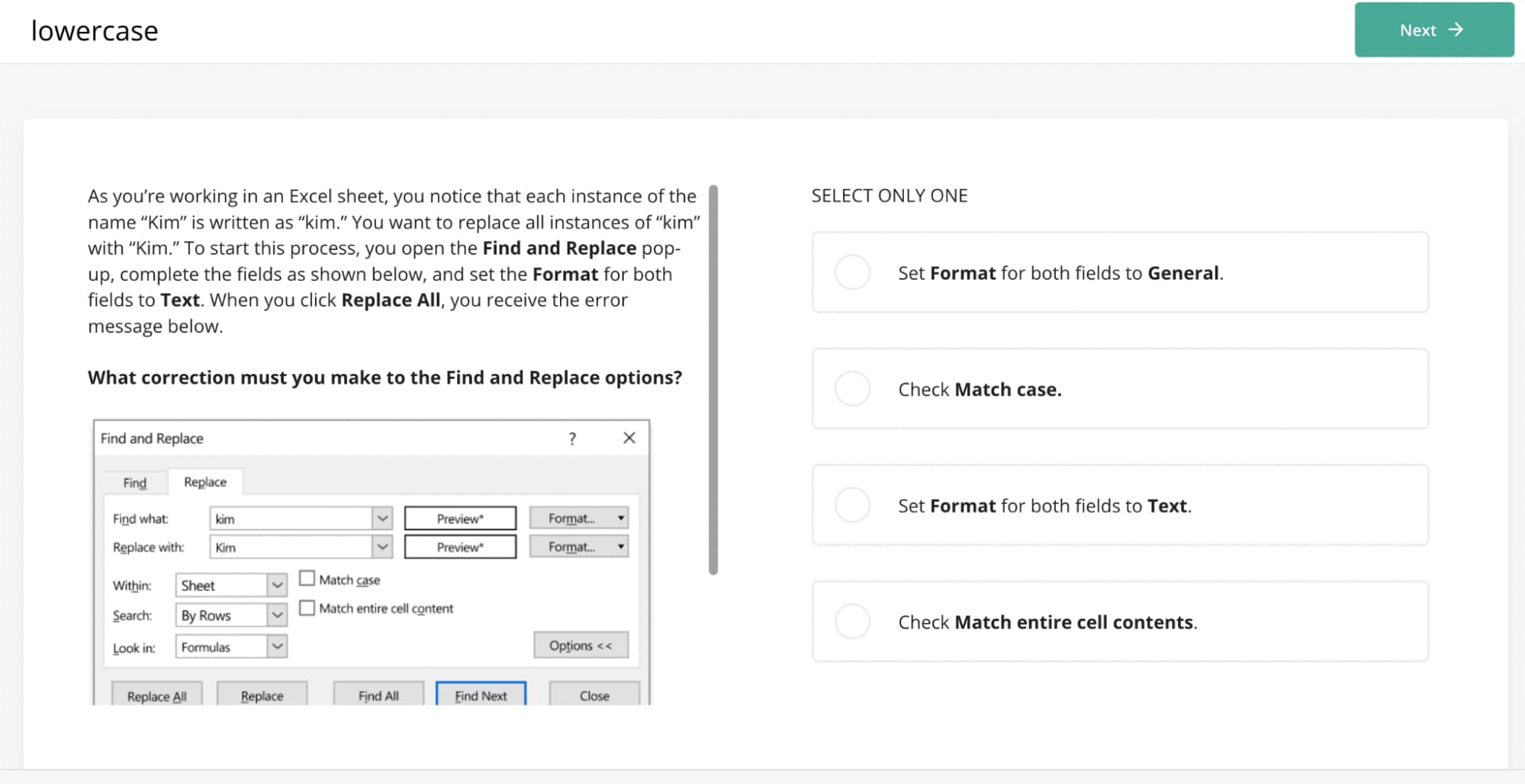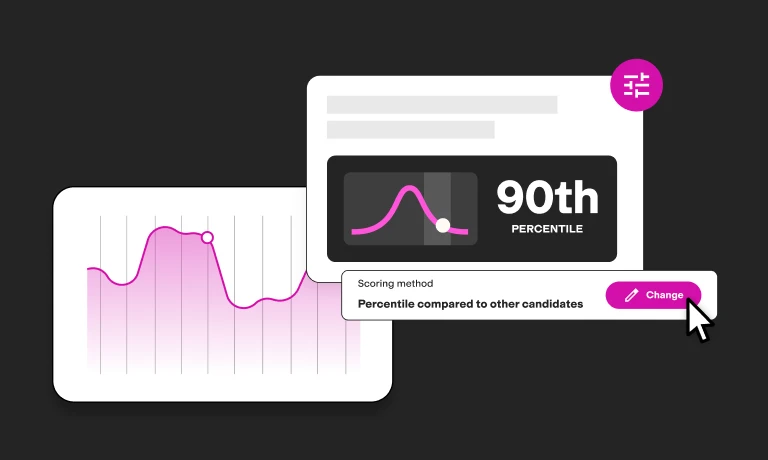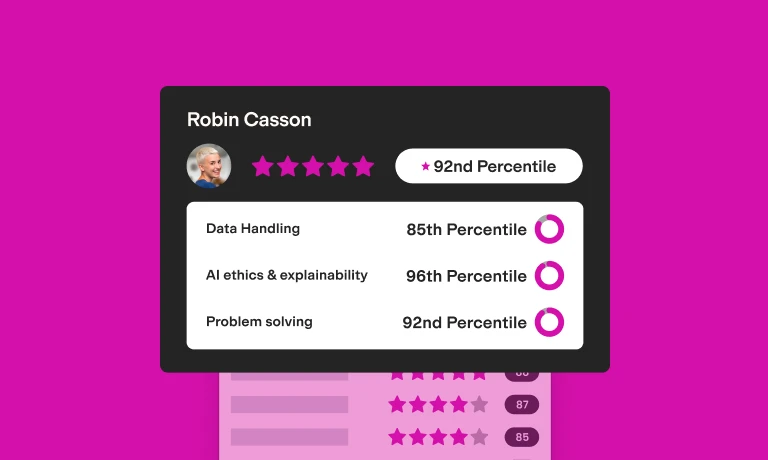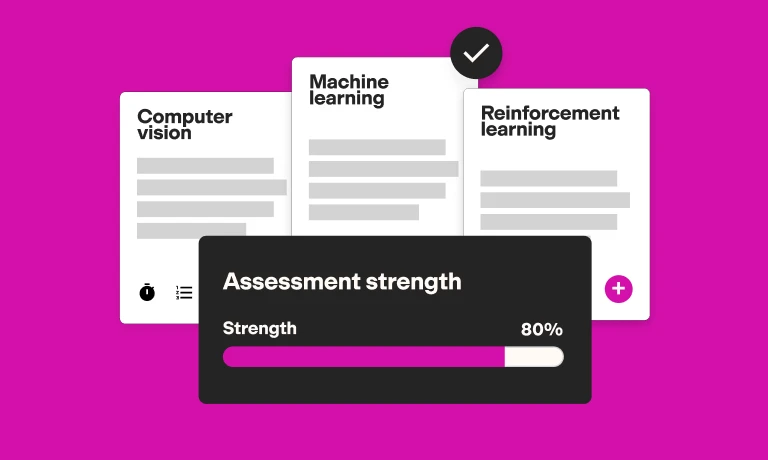Talent pipelines: How to leverage this talent acquisition strategy and hire better candidates faster
HR leaders know that posting an open role involves much more work than just announcing a vacancy on LinkedIn.
You must research talent acquisition trends and the job’s requirements, write a comprehensive job description, and source amazing candidates for your applicant tracking system. Then you must assess applicants, preferably without using resumes, interview your best prospects, and negotiate a winning offer.
It’s a lot of work – especially when you have many job openings on short notice, and you must fill them right away.
But what if we told you it was possible to cut that workload in half?
With an effective talent pipeline that helps you maintain a pool of qualified candidates, you don’t have to source candidates.
That means shorter times-to-hire, smoother processes for HR staff, and a huge opportunity to plan your recruitment strategy. It makes other talent acquisition strategies work more effectively for your business.
Read on to learn how talent pipelines work and how to leverage them to stay ahead in the race for top future talent.
Table of contents
- What is a talent pipeline?
- Why is building a talent pipeline important?
- The benefits of a talent pipeline
- 8 best practices for leveraging a talent pipeline strategy to acquire top talent
- 4 examples of companies succeeding with a talent pipeline as a talent acquisition strategy
- Build a skills-based talent pipeline to hire faster and smarter
What is a talent pipeline?
A talent pipeline is a pool of qualified external candidates that a business contacts when suitable roles open up.
Hiring managers consider those candidates for those roles based on their knowledge of the candidates’ skills and abilities.
This talent acquisition strategy is a form of proactive recruitment or reaching out actively to potential hires who can benefit your succession plan rather than waiting for candidates to come to you.
That way, you build relationships with passive candidates so they’re primed and ready to step up when needed.
Because the talent pipeline approach is inherently forward-thinking and prioritizes your business’s long-term needs over immediate requirements, it forms an important part of any hiring plan.
A good talent pipeline should consider your company’s future needs. That way, your business is ready to deal with the challenges of high employee turnover rates as quickly and efficiently as possible when they arise.
Why is building a talent pipeline important?
First and foremost, a talent pipeline fosters a proactive recruitment strategy that enables your company to plan for the long term. It helps you identify the skills you need and prepare to meet them.
Companies that build a talent pipeline don’t need to scramble to source job seekers every time a role opens up.
A lot of work is cut out of the hiring process, reducing time-to-hire and improving hiring efficiency.
That frees your HR staff to focus on the more involved aspects of the recruitment process. With no need to worry about posting open positions externally and ensuring that the right candidates see them, they can concentrate on:
Writing job descriptions
Compiling ideal candidate profiles
Conducting interviews and skills tests
Staying in contact with the candidates in your pipeline
All of those elements of the process have a direct impact on candidate experience, too. Freeing up your HR teams to plan and execute a successful recruitment process – and to keep candidates in the loop throughout – leaves a better impression on applicants.
Lastly, building a talent pipeline is a great way to engage passive candidates who aren’t actively looking for work.
These candidates make up roughly 37% of US workers – a huge talent pool that most traditional recruitment methods fail to tap into. Ironically, passive talent doesn't respond to passive recruiting methods, and so most companies lose out on what they have to offer.
But by engaging them directly and proactively with your talent pipeline strategy, you gain a head start over your competitors in the talent search.
A talent pipeline makes it faster, easier, and more efficient to put great new hires into suitable roles and to ensure they have a positive experience in the process.
The best insights on HR and recruitment, delivered to your inbox.
Biweekly updates. No spam. Unsubscribe any time.
The benefits of a talent pipeline
Recruiting from a talent pipeline comes with practical benefits for employers.
Here are the biggest advantages of adopting a talent pipeline strategy.
Improve your company’s diversity
Diversity in the workplace doesn’t just improve morale and creativity. It also makes your business more successful.
More than 70% of businesses with gender equality policies report higher productivity and profits.
Instead of waiting for diverse candidates to stumble across your job ads, try seeking them out and nurturing them by building a diverse talent pipeline.
It’s a reliable way to foster inclusive hiring practices and ensure that a wider range of candidates enjoys an equitable chance of success within your company.
Fill open roles more efficiently
According to the Society for Human Resource Management, it takes businesses 36 days on average to fill an open role.
If an existing employee quits without notice, it results in more than a month of struggling to cover essential business functions and kick-starting a frantic, reactive hiring process.
But if you have a talent pipeline, you’re well placed to skip the panic because you already have potential candidates waiting to hear from you.
Reach out to them and get the recruitment process in motion much faster.
Create a better candidate experience
When surveyed, 81% of candidates said that their experience of a company’s recruitment process influenced their decision to accept or decline an offer.[1]
Factors that affect candidate experience include:
The organization and speed of the recruitment process
The alignment of a role’s responsibilities with the candidate’s expectations
A candidate’s experience with the people involved in recruiting
Hiring from a talent pipeline fosters a better candidate experience because it’s faster and more efficient than reactive recruiting. It also gives recruiters and hiring managers more time to build a positive relationship with each candidate.
A good candidate experience at this stage boosts employee retention and satisfaction later.
And according to the same survey, candidates are more likely to review a positive hiring experience online. That means a good candidate experience also helps your employer branding.
8 best practices for leveraging a talent pipeline strategy to acquire top talent
You’ve come to the right place if you’re ready to learn more about the talent pipeline approach.
Read on for 8 top tips on building a talent pipeline and the most important principles of talent pipeline management.
Using a talent pipeline strategy at a glance
Strategy | How it helps |
1. Conduct a skills gap analysis to determine your future needs | Shows you the skills your business needs and guides your development of a talent pipeline |
2. Build an ideal candidate profile | Helps you to match candidates in your pipeline to suitable roles using objective data on skills |
3. Use talent acquisition analytics to build your pipeline | Ensures your pipeline is data-driven, equitable, and fairly managed |
4. Attract candidate interest with recruitment marketing | Makes it easier to source and engage the candidates you need to fill skill gaps |
5. Consider adding internal candidates to your pipeline | Promotes internal mobility and positions your company as a place for top talent to build lasting careers |
6. Keep former employees in mind | Unlocks an untapped pool of talent and uses a growing talent acquisition trend |
7. Engage and nurture your pipeline | Limits attrition in your talent pipeline and fosters a better candidate experience |
8. Reassess your talent pipeline regularly | Keeps your business well prepared to meet its long-term skills needs |
1. Conduct a skills gap analysis to determine your future needs
A key part of building a talent pipeline is knowing the kind of employee you’ll need to hire in the future. That strategic workforce planning process determines whose interest you try to attract as your talent pipeline takes shape.
First, you need to find out where the skills gaps are in your organization.
The most efficient way is to carry out a skills gap analysis.
This method involves comparing the skills you need with your employees’ skills. It helps companies build strategies for internal learning and development, including recruitment.
Here’s how you conduct a skills gap analysis:
Define your company’s business goals for the medium and long term
Identify the skills your employees need to complete these goals
Set up assessments to determine whether your employees have these skills – like this test designed to assess an employee’s proficiency in Microsoft Excel
Use the results to see where skills gaps exist in your company.
Once you know where your organization has skills gaps, you can gear your talent pipeline toward recruiting to fill those gaps.
2. Build an ideal candidate profile
An ideal candidate profile (ICP) describes what a candidate needs to succeed in an open role. It should include their:
Hard skills
Soft skills
Motivation
An ICP can include specifications for a candidate’s work experience, education, social background, or age.
But it’s important to remember that focusing on these criteria could limit your ability to find the best candidates by introducing bias to the process.
At its worst, it could even take the form of hiring discrimination.
That’s why it’s better to create a skills-based ICP that focuses on the core competencies needed to carry out a role.
As you build your talent pipeline, good ICPs are invaluable. Here’s how they work alongside a talent pipeline strategy:
Determine the skills needed for a role (using skills gap analyses where necessary) and create an ICP
Carry out talent assessment tests for each prospective candidate in your talent pipeline
Use the objective candidate data gathered from the testing process to match candidate skills to ICPs
Match candidates to roles on that basis
3. Use talent acquisition analytics to build your pipeline
A talent pipeline requires you to be able to plan for the future. And just like any other process, planning is easier when you have reliable data to guide you.
Talent acquisition analytics are the trackable metrics that help guide your recruitment process.
They’re a vital part of a data driven recruiting policy.
Make sure your talent pipeline is expanding in the right direction by tracking the following metrics:
Employee turnover: voluntary departures from your company
Employee attrition: involuntary departures from your company
Employee retention: how long your employees stay with your business
Employee upskilling and reskilling: which of your employees are learning new skills, and what they’re learning
These metrics help you predict where future roles are likely to open, when you need to recruit, and which skills candidates need.
Use that information to target how you promote your talent pipeline – which we’ll get into in the next step.
4. Attract candidate interest with recruitment marketing
Now that you’ve figured out the kind of candidate you need in your talent pipeline, it’s time to start catching their attention.
That means a recruitment marketing push to promote your company, what it stands for, and what it offers as an employer. Use strategies like social media recruiting and employer branding to show candidates the value of working for your company. That could include promoting your values, compensation and benefits package, and any training opportunities you offer.
It’s all about pitching your business as a great place to work.
Once you’ve identified your talent pipeline needs, you need to pitch specifically to the type of candidate you want to engage to meet your hiring needs.
That could be as simple as posting on job boards specific to the role you’re recruiting for or as complex as showing how your company’s culture and values meet the needs of a specific demographic.
Use the talent acquisition metrics you researched in the previous step to guide your approach to recruitment marketing.
5. Consider adding internal candidates to your pipeline
When recruiting, looking outside your company to find talent seems obvious.
But have you considered that your next best hire could be working for you already?
Your current employees already know your company and how it works. They understand the culture, and if you’ve hired them effectively, they already contribute to it daily.
You can avoid a lengthy onboarding process when you recruit from an internal talent pipeline. Because your employees already have institutional knowledge, they are ready to hit the ground running.
Another key advantage to adding internal candidates to your talent pipeline is that it could bolster your ability to recruit top talent externally, too.
Candidates value internal mobility. They want to work for companies where they know they can build long-term careers instead of becoming stagnant.
If your company can show a culture of internal mobility, you’re more likely to attract candidates who want to stay with you long-term and boost your ability to retain top employees.
6. Keep former employees in mind
If internal candidates are one untapped source of talent, former employees – sometimes called “boomerang employees” – are another great talent pool to draw on for your pipeline.
Nearly 20% of the employees who quit their jobs in recent years have since returned to their old employers.
Rehiring former employees is becoming a trend that’s hard to ignore.
First and foremost, your former employees are known quantities. You already know these candidates because you’ve already worked with them.
That means you understand their skills and capabilities, making matching them with open roles easier.
They’re also likely to return to you with new adjacent skills they’ve learned in subsequent jobs – an easy benefit for your business.
When rehiring, it’s important to be conscious of biases that could affect your hiring decisions. Remember, you already know these candidates; your existing knowledge could shape your hiring decision.
But it’s worth considering these candidates as you develop your talent pipeline.
7. Engage and nurture your pipeline
Talent pipelines are great for employers because they enable you to keep top talent in reserve.
But candidates don’t always feel good about waiting for an opportunity to take shape. They could opt for job offers with more immediate prospects instead.
You can lose your talent pipeline if you don’t keep it engaged.
Here’s how to build the habit of candidate nurturing and ensure your pipeline stays engaged with your company:
Communicate frequently and transparently: When surveyed, 63% of candidates said they were unhappy with the lack of communication from hiring managers[2]
Keep communications personalized and human: Candidates want to feel appreciated as individuals
Engage candidates in your company and culture directly: Invite them to events and internal comms channels, or just keep in touch using a newsletter or social media
Recognize and reward candidates: They’re putting time, effort, and energy into this process, and celebrating their work keeps them engaged
8. Reassess your talent pipeline regularly
A talent pipeline enables you to recruit based on your expected future needs. But crucially, those needs don’t stay static over time.
As your company grows and your goals shift, you must monitor and evaluate your talent pipeline regularly.
Otherwise, it could get stale, and you keep candidates who aren’t a good fit for your changing needs on standby.
That’s a guaranteed way to create a terrible candidate experience and harm your company’s reputation.
Here’s how to keep evaluating your talent pipeline:
Check in regularly to determine whether your company’s long-term business goals have changed
Perform skills gap analyses regularly to track your progress in filling skills gaps
Monitor your talent acquisition metrics and respond proactively to any shifts
Adjust your recruitment marketing when necessary to ensure you’re targeting the candidates you need most
Most importantly, communicate with your talent pipeline about any changes
If you’re proactive about assessing your talent pipeline, you’ll have greater success with the strategy over the long term.
4 examples of companies succeeding with a talent pipeline as a talent acquisition strategy
Before you start to implement your talent pipeline, let’s look at how real companies are using this strategy.
Let’s look at four case studies of four different talent pipeline strategies and our insights into how each approach works.
Talent pipeline success stories at a glance
Company | How it’s succeeding |
Apple | Providing career development opportunities to Black students to encourage hiring diversity |
Delta | Collaborating closely with local technical colleges to ensure students are as prepared as possible to work with the company |
IBM | Creating skills-based talent pipelines to ensure candidates have what they need to fill their new roles |
Lockheed Martin | Offering a range of structured training programs to suit a diverse range of candidate backgrounds |
Apple
Apple, the Silicon Valley tech giant, offers a great example of a tech talent pipeline in action.
It participates in the Apple HBCU Scholars Program, a scheme developed in partnership with historically Black colleges and universities. The program offers a $15,000 merit-based scholarship and an internship opportunity to selected eligible students.
It isn’t exclusively for future tech workers, either. The program has a route for students with a non-technical focus, including those specializing in business, communications, and finance.
Although the company doesn’t guarantee students a job at the end of the internship, students gain access to long-term coaching and mentorship opportunities with existing employees.
It’s a way for the firm to keep in touch and continue nurturing this prospective future talent.
That way, when they’re ready to enter the world of work, the company has a direct line to them if suitable roles open up.
By focusing this recruitment strategy on Black students, historically marginalized in tech, the business fosters a good company culture that foregrounds diversity and inclusion.
Delta
Delta, a Georgia-based airline, works closely with students and young people to keep its talent pipeline flowing.
In partnership with Atlanta Technical College and its Aviation Maintenance Airframe Certificate Program, the firm’s TechOps division provides curriculum support so students are qualified to be hired by the airline when they graduate.
In 2018, the airline contributed $500,000 to the college to ensure program recertification.
And its pipeline-building efforts aren’t solely focused on Atlanta Technical College. It also contributed $250,000, shared between five technical colleges in Georgia, to promote and support avionics and composite training.
Because the airline’s home base is in Georgia, this project represents an effort to nurture local talent in the firm’s home state.
The colleges benefit from financial support and students enjoy more stable paths to employment after building the necessary skills.
It’s a hands-off approach to campus recruitment, but an effective one.
IBM
IBM, an international technology corporation, is known for its skills-based approach to recruitment initiatives. In recent years, it’s moved toward reworking job descriptions to be skills-focused and avoid relying on work experience or academic credentials.
Since then, it’s taken the logical next step – providing ways for potential employees to develop the skills they need to work for the company.
In 2011, the firm established P-TECH, a partnership between high schools, community colleges, and industry partners. These schools enable young people from under-served backgrounds to build academic, technical, and professional skills.[3]
The result?
Students leave P-TECH schools with a high school diploma and a two-year associate degree.
P-TECH schools are free, and they don’t have any testing or grade requirements. They’re a lifeline to students who may not be able to access other pathways into education and they’re a great way for the firm to build a workforce focused on skills.
This approach is the ideal complement to its skills-based hiring policies.
Lockheed Martin
Lockheed Martin, an international aerospace and defense company, invests heavily in various talent pipelines.[4]
To engage and nurture external talent, it offers apprenticeships that enable prospective future hires to develop the skill sets they need to thrive within the company. They’re paid for their work, meaning the apprenticeship represents the first step on a career path.
It’s committed to creating 8,000 apprenticeships to maximize opportunities for young people.
It’s also spent time creating an internship program for high school and college students in partnership with local schools and external organizations promoting careers in STEM.
But most significantly, the firm offers upskilling opportunities to existing workers who want to advance.
It treats all of its existing employees as a talent pipeline in its own right and uses them as a means to close skills gaps without the hassle of hiring.
This wide-ranging approach means the company is never short of the right talent to nurture and engage, no matter where it comes from.
Build a skills-based talent pipeline to hire faster and smarter
A robust talent pipeline makes talent planning simple.
By planning to meet your business’s projected future needs, you reduce your time-to-hire, save your HR team’s time, and maximize the quality of your new employees.
A data-driven, skills-focused pipeline ensures that your business has a steady supply of talent ready to hire. All you have to do is keep your talent pipeline candidates engaged and ensure your pipeline adapts as your needs change over time.
Preparation saves time, so start building your talent pipeline today and prepare your business for the future.
Want to learn more about maintaining good relationships with your talent pipeline? Check out our candidate relationship management guide to ensure your prospective employees stay engaged and excited about your firm.
And don’t forget to use our Motivation test when hiring. It’s a great way to ensure your talent pipeline’s goals and expectations align with those of your company.
Sources
Palmeri, Shelby. (February 6, 2023). “2023 Candidate Experience Report”. CareerPlug. Retrieved August 22, 2023. https://www.careerplug.com/blog/candidate-experience-statistics/
“Candidate Experience Report: Perceptions and Behaviours”. Talentegy. Retrieved August 9, 2023. https://www.talentegy.com/hubfs/2019%20CX%20Report/Talentegy-2019%20Candidate%20Experience%20Report.pdf
Corrigan, John. (September 12, 2022). “IBM SVP reveals how tech giant nurtures its future workforce”.x HCA. Retrieved August 9, 2023. https://www.hcamag.com/us/specialization/learning-development/ibm-svp-reveals-how-tech-giant-nurtures-its-future-workforce/420023
“Economic and Workforce Impact”. Lockheed Martin. Retrieved August 9, 2023. https://www.lockheedmartin.com/en-us/who-we-are/economic-and-workforce-impact.html
You've scrolled this far
Why not try TestGorilla for free, and see what happens when you put skills first.
















